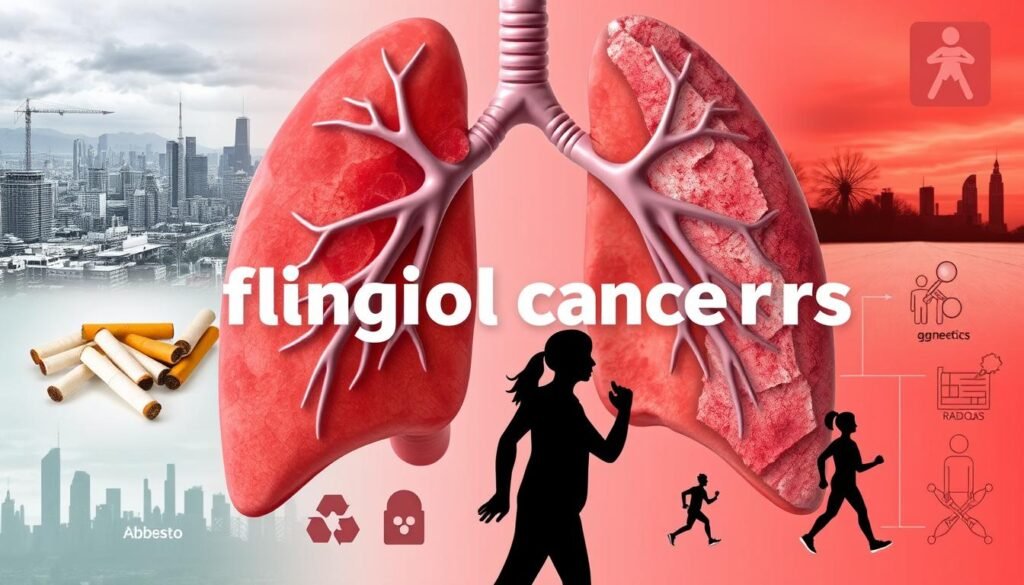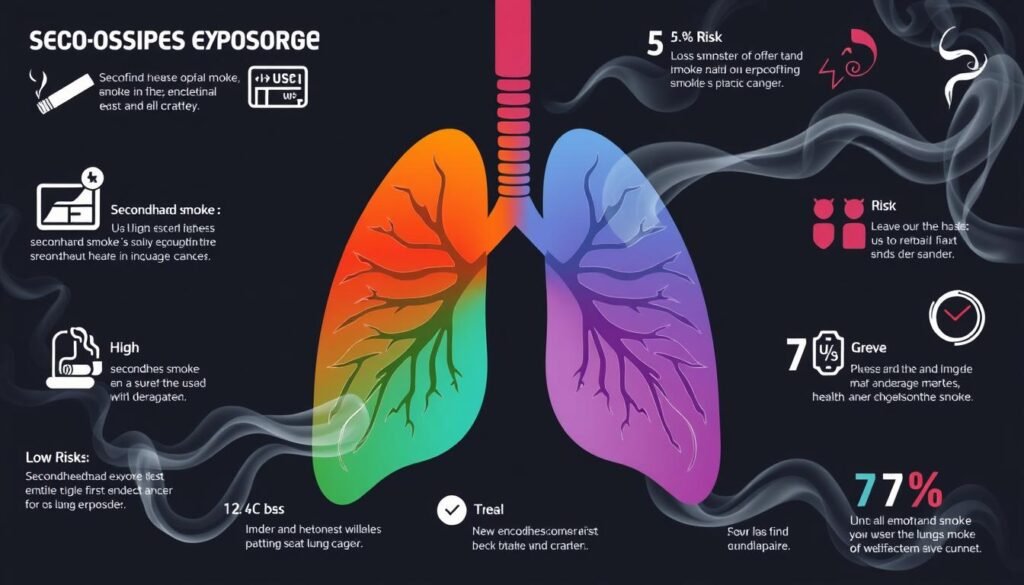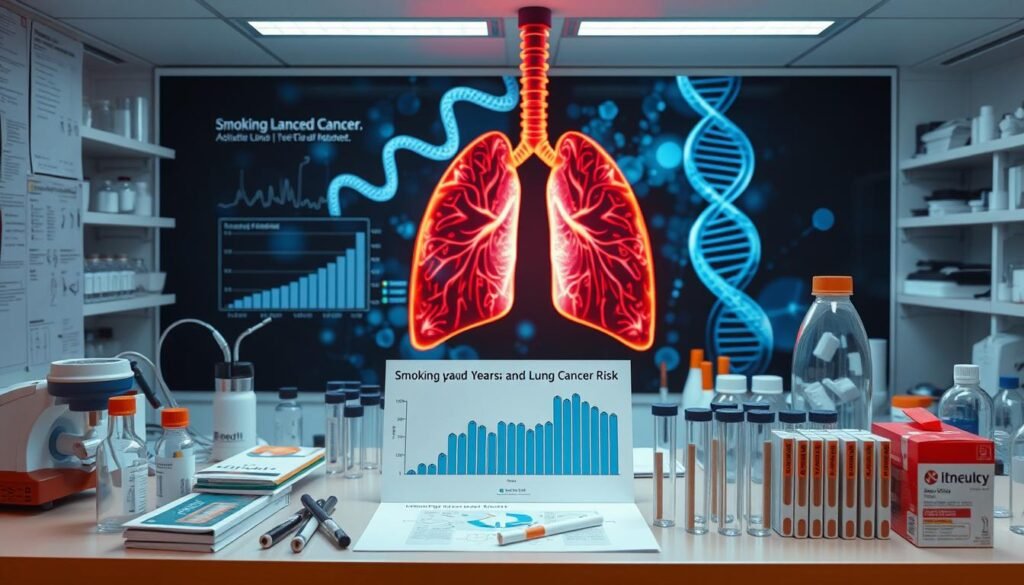Lung cancer is the top cause of cancer deaths in the U.S., responsible for about 25% of all cancer deaths. A key factor in this statistic is smoking history, especially when measured by pack years. A pack year means smoking one pack of cigarettes every day for a year. This measure is vital for figuring out lung cancer risk. Smoking’s link to lung cancer is not simple. Both how much and how long someone has smoked matter a lot for understanding their risk.
Studies show that looking at how long someone has smoked tells us more about their lung cancer risk than just considering the number of cigarettes smoked daily. This fact underscores the importance of both pack years calculation and smoking duration in assessing risks. Thus, it’s crucial to delve into the details of smoking history to grasp its impact on lung cancer fully.
Knowing this encourages the importance of regular checks, especially for those at high risk based on their smoking past. Early detection through these screenings leads to better health outcomes. It highlights why it’s essential to be proactive about health screenings.
Key Takeaways
- Lung cancer is the leading cause of cancer death in the U.S., with smoking being a significant factor.
- Pack years combines smoking duration and intensity, providing a more comprehensive assessment of risk.
- Women may develop lung cancer after fewer pack years compared to men due to greater susceptibility.
- Former smokers maintain a higher lifetime risk for lung cancer and heart-related illnesses, regardless of pack years.
- Yearly lung cancer screenings are recommended for those aged 50 to 80 with a substantial smoking history.
Understanding Pack Years and Its Importance
Pack years are vital in assessing smoking exposure, especially when considering lung cancer risk. They help doctors predict the chance of getting smoking-related diseases. Knowing what pack years mean aids in smarter decisions about clinical assessments of smokers.
Definition and Calculation of Pack Years
Calculating pack years is simple: it’s the daily packs of cigarettes multiplied by smoking years. For instance:
- 1 pack/day for 20 years equals 20 pack years.
- 2 packs/day for 15 years total 30 pack years.
- Half a pack/day for 30 years results in 15 pack years.
This method helps link smoking levels to health problems like lung cancer. People with more pack years face higher risks of diseases. It highlights the importance of this measurement.
How Pack Years Are Used in Clinical Settings
In clinics, pack years guide lung cancer and disease risk assessments. Patients with over 15 pack years are at increased risk. This categorization helps in creating targeted health screenings and interventions. Doctors use this info to watch over and plan patient care effectively.
Link Between Smoking and Lung Cancer
Extensive research shows a clear link between smoking and lung cancer. Smoking accounts for 85 percent of lung cancer cases. In the U.S., smoking causes about 480,000 deaths every year.
Statistics on Lung Cancer and Smoking
There’s a pressing need for awareness about the risks of smoking. Consider the following:
- Quitting smoking before 40 cuts the risk of dying from smoking-related diseases by 90 percent.
- People who quit by 54 reduce their risk of premature death significantly.
- Quitting smoking after being diagnosed with cancer can drop death rates by up to 40 percent for some cancers.
In 2020, lung cancer caused around 1.8 million deaths globally. It stands out as a major health concern. Non-small cell lung cancer (NSCLC) makes up 85 percent of these cases. It has recently been affecting more men than women.
Mechanism of Carcinogenesis in Smokers
Smoking is harmful because of the carcinogens in tobacco smoke. These chemicals cause mutations in DNA. They disrupt cell mechanisms, leading to cancer. Smoking is a major cause of lung cancer. It shows why quitting smoking is vital.
Differences in Lung Cancer Risk Based on Pack Years
Studies have consistently linked pack years to lung cancer risk. They show a strong connection between the amount smoked and cancer risk. People who’ve smoked more face higher chances of lung cancer. Even those who quit smoking years ago still have a higher risk.
Evidence from Epidemiological Studies
Research highlights a clear link between smoking years and lung cancer diagnosis. Smoking is behind about 90% of lung cancer cases. Smokers have a risk of lung cancer nearly 20 times higher than nonsmokers. In 2020, around 228,820 people in the U.S. were diagnosed with lung cancer, resulting in 135,720 deaths.
Comparison of Risk Among Smokers of Varying Pack Years
Data shows smokers with extensive pack year histories face different levels of risk. High pack year count leads to greater dangers. Doctors advise lung cancer screenings for those aged 50-80 who’ve smoked 20 pack years. This advice underscores the link between smoking amount and cancer risk. Yet, only 14.4% of those eligible have been screened, indicating many are unaware of their risk.
Factors Influencing Lung Cancer Risk Beyond Pack Years
When looking into lung cancer risks, it’s key to think about more than just pack years. The age someone starts smoking and how long they’ve smoked are key factors. If someone starts smoking early, it can make them more likely to get lung cancer later on.
Age of Onset and Duration of Smoking
Young smokers face tougher challenges for their lung health. Smoking for a long time makes things worse because tobacco’s harmful stuff damages the lungs slowly. Studies show that being exposed longer to these bad substances makes cancer more likely. This shows why we must think about how long someone has smoked, not just pack years.
Gender Differences in Lung Cancer Susceptibility
Gender plays a role in lung cancer risk too. Research shows women can get lung cancer with fewer pack years than men. This suggests we need to look into how biological differences, like hormones, might impact risk for women. The rising number of women with lung cancer points to changes in smoking patterns and risks. It shows how gender can change the risk of lung cancer.

| Factor | Impact on Lung Cancer Risk |
|---|---|
| Age of Onset | Earlier onset results in higher risk due to longer exposure to carcinogens. |
| Smoking Duration | Longer duration increases cumulative exposure and damage to lung tissue. |
| Gender Differences | Women may face higher risks with fewer pack years compared to men. |
Impact of Smoking Cessation on Lung Cancer Risk
Quitting smoking brings many benefits, including a big drop in lung cancer risk. This effect can motivate people to stop smoking early. Over time, the benefits get even bigger.
Time Frame for Risk Reduction
After quitting, former heavy smokers cut their lung cancer risk by about 39.1% in five years. But, they still have a higher risk compared to never-smokers. For example, former smokers have a lung cancer rate of 1.61 per 1000 person-years, which is lower than current smokers but higher than never smokers.
Even 15 years after quitting, the risk of lung cancer remains but is much lower. This shows why it’s important to keep up with health checks.
Importance of Quitting Early
Quitting smoking as soon as possible greatly reduces lung cancer risk. The risk for people who quit less than five years ago is much lower than for those who keep smoking. With more time smoke-free, their risk gets closer to that of never-smokers.
People who quit early not only reduce their lung cancer risk. They also improve their overall quality of life. Staying smoke-free for a long time helps lower risk, even if it never matches that of never-smokers.
| Time Since Quitting | Relative Cancer Risk |
|---|---|
| Current Smokers | 1.97 per 1000 person-years |
| Former Smokers (5 years post quitting) | 1.61 per 1000 person-years |
| Never Smokers | 0.26 per 1000 person-years |
Role of Secondhand Smoke Exposure
Secondhand smoke is a big health risk. It especially raises the chance of lung cancer in non-smokers. They face serious health issues from being around tobacco smoke. Knowing the facts can help make better public health rules.
Statistics on Secondhand Smoke and Lung Cancer Risk
Studies show that secondhand smoke at work or during free time can increase lung cancer chances. The risk is higher for exposure before turning 25. If exposed after 25, the risk goes down.
Non-smokers exposed before 25 have a higher risk of lung cancer. But, if exposure happens after 25, their risk decreases. The risk is higher for everyone exposed compared to those who aren’t. Being around smoke for 2-3 hours daily doubles the lung cancer risk. More than three hours, and the risk goes up even more.
Additional Risks for Non-Smoking Individuals
Non-smokers, especially children and pregnant women, face big health risks. Secondhand smoke increases the lung cancer risk by a noticeable amount. Kids suffer in their growth and breathing because of it. We need to cut down on secondhand smoke to protect non-smokers.

| Exposure Scenario | AOR for Lung Cancer Risk | Relative Risk |
|---|---|---|
| Never smokers exposed to SHS | 1.69 (95% CI: 1.13–2.52) | — |
| 2-3 hours exposure to SHS | 2.27 (95% CI: 1.13–4.53) | — |
| More than 3 hours exposure to SHS | 2.29 (95% CI: 1.20–4.37) | — |
| Overall exposure to SHS | 1.24 (95% CI 1.16–1.32) | — |
| Exposure before age 25 | 1.29 (non-smokers) | — |
Lung Cancer Screening Recommendations
Lung cancer screening is key for catching the disease early, especially for those who smoked a lot. Experts recommend yearly checks with a special kind of scan called low-dose computed tomography (LDCT) for people who are at high risk. If you’re between 50 to 80 years old and have smoked for 20 pack-years or quit in the past 15 years, you should get these screenings.
Guidelines Based on Pack Year History
The U.S. Preventive Services Task Force (USPSTF) has set clear rules for lung cancer checks. They focus on how much you’ve smoked over the years, because it affects your lung cancer risk. Here’s what they suggest:
| Age Group | Pack Year History | Smoking Status | Recommended Screening |
|---|---|---|---|
| 50-80 years | 20 pack years or more | Current or former (quit within 15 years) | Annual LDCT Screening |
Benefits of Early Detection Through Screening
Finding lung cancer early can save lives. If caught at the localized stage, the 5-year survival rate can reach up to 52.2%. That’s a big jump from 16.8% for later stages. Regular screenings mean doctors can act fast to treat cancer. This is crucial because lung cancer is behind about 28% of all cancer deaths in the U.S.
Smoking-Related Diseases Other Than Lung Cancer
Lung cancer is well-known, but smoking harms more than just the lungs. Smokers have a higher chance of getting heart disease and COPD. Knowing more about smoking’s effects can help tackle public health problems.
Heart Disease and Smoking Correlation
Many studies show smoking and heart disease are closely linked. Smoking hurts blood vessels, leading to plaque buildup. This can cause heart attacks and strokes. Smokers have a much higher risk of heart disease than non-smokers. This information highlights the importance of reducing smoking.
COPD and Other Respiratory Diseases
COPD is mainly caused by smoking. The toxic chemicals in smoke inflame and harm the lungs. This leads to breathing issues and reduced lung function. Smoking also raises the chance of respiratory infections and can worsen lung diseases. It’s key to notice COPD symptoms early. This can prevent serious problems like lung cancer.
A study shows COPD may hide signs of lung cancer. This makes early diagnosis harder. Knowing how these diseases overlap is crucial for better treatment and health results. For details on telling these illnesses apart, visit COPD and lung cancer symptoms.
Tobacco Prevention Programs and Their Importance
Tobacco prevention programs are key in lowering smoking rates and related health risks. These risks include lung cancer. The programs combine education, policy actions, and community work. They use campaigns, outreach, and support services to cut down on smoking.
Strategies for Decreasing Smoking Rates
Many methods are effective in cutting smoking numbers. Some main strategies are:
- Public health campaigns: These raise awareness about smoking dangers through ads and workshops.
- Cessation resources: It’s crucial to have access to help and materials for those trying to quit.
- Legislative measures: Bans in public places help lower exposure and make not smoking the norm.
- Tobacco taxes: Higher taxes on products can stop new smokers, especially youths.
The Role of Education in Tobacco Prevention
Teaching the public about smoking greatly influences choices and views on tobacco. Highlighting the dangers and cessation benefits educates communities. These efforts focus on:
- School programs: Tobacco education in schools helps youths choose wisely.
- Community outreach: Workshops and sessions raise awareness of related diseases.
- Support networks: Connecting people with resources provides support for quitters.
Tobacco prevention programs do more than lower smoking rates. They lead to healthier communities by cutting down smoking-related diseases. By emphasizing education and effective methods, these programs aim for a future with fewer tobacco-related health risks.
Current Research on Smoking and Lung Cancer
Recent smoking-related research highlights vital links between smoking habits and lung cancer rates. It focuses on how smoking, measured in pack years, affects cancer risk. Diverse methods help capture smoking’s impact on lungs, especially across different genetic backgrounds.
Ongoing Studies in Lung Cancer Risk Assessment
Current research looks at the smoking-lung cancer connection using advanced stats. It uses polygenic risk scores from genetic variations to gauge risk. Findings show heavy smokers have a much higher risk of lung cancer.
Emerging Insights on Pack Years Calculation
It’s key to accurately calculate pack years to know lung cancer risk. Lung cancer risk assessment studies show this helps in making prevention plans. Quitting smoking can majorly drop the risk, potentially preventing 76.4% of new cases.

Research on smoking and lung cancer keeps evolving. Pack years research insights are crucial. Newer studies will offer more on prevention and early detection. For more info, check the latest academic journals.
Patient Resources and Support for Smokers
People who want to stop smoking have many key resources available. Each one gives important tools and support. This is vital for a successful quit journey.
Access to Smoking Cessation Programs
There are many kinds of smoking quit aids available. They range from detailed programs to simple self-help tools. These often feature:
- Behavioral therapy and group sessions
- Pharmacotherapy, such as nicotine replacement therapy
- Online resources and applications to track progress
Community health centers and hospitals offer supports tailored to quitting. This makes it easier for people to find the right program. Also, groups like the American Lung Association have a lot of resources to help quit smoking.
Finding Support Groups and Counseling
Being part of support groups really helps with quitting. It makes you feel you’re not alone and helps stay motivated. There are many groups, both local and online, that offer support and understanding. Counseling, whether one-on-one or in groups, teaches useful tips to handle cravings.
There are hotlines for instant help too, making support just a call away. Getting support can make a big difference in quitting success and health improvement.
Conclusion
The recap of lung cancer risk highlights the link between smoking and lung cancer. It shows the role of pack years in assessing risk. The importance of quitting smoking is also emphasized as a key step to reduce this risk. Studies like the National Lung Screening Trial have shown that tests like low-dose helical CT are good at spotting lung cancer early on. This improves chances of successful treatment.
Heavy smokers have a higher risk of lung cancer. This makes it critical to understand the impact of lifestyle choices such as smoking. In places like Korea, Japan, and China, smokers face different levels of risk. This is due to genetics, environment, and smoking habits. Therefore, public health efforts should highlight smoking risks and offer help to quit.
In closing, the data points to a worrying link between smoking and lung cancer deaths. Yet, it also offers hope. Quitting smoking greatly reduces lung cancer risk. There are resources available for those looking for help, such as smoking cessation programs and lung cancer screenings. It’s important to keep educating people and preventing smoking-related diseases to improve health for smokers and ex-smokers. For more info, check out the National Lung Screening Trial.